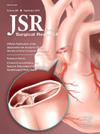Enhancing Pre-clerkship Students' Readiness for Surgery: A Kern's Framework-Guided Workshop
IF 1.7
3区 医学
Q2 SURGERY
引用次数: 0
Abstract
Background
The transition from preclinical years to surgical clerkship is challenging, as traditional curricula emphasize didactic learning over technical and interpersonal skills. We developed a novel, structured workshop based on Kern's Six-Step Guide to Curriculum Design to enhance medical learners' clerkship readiness.
Materials and Methods
Conducted in 2023 and 2024 at a single Canadian institution, the workshop featured five stations: Introduction to the OR, The Surgical Ward, The Surgical Consult, Technical Skills, and Thriving in Surgical Clerkship. A multidisciplinary team of surgeons, trainees, nurses, and a clinical clerk facilitated clinical vignettes, small-group discussions, and operative simulations. Learners’ confidence and knowledge were assessed through pre- and postworkshop questionnaires, and suturing skills were evaluated using a validated tool. Comparative analyses were performed using Paired T-tests and Wilcoxon signed-rank tests.
Results
Fifty-nine (95.2%) medical students were included in the analysis after removing incomplete responses. Forty-one students (69.0%) had little (less than five times) or no exposure to an OR in the last year. Learners’ overall median confidence improved significantly post-workshop [2.0 (IQR: 2.1-3.2) versus 6.4 (IQR: 6.3-6.8) P = 0.005], as did their suturing skills (11 ± 4.8 versus 23 ± 2.4, P < 0.0001). Fifty-one learners (86.4%) agreed that the workshop decreased their anxiety around clerkship. All agreed that the workshop should be offered again.
Conclusions
Our workshop effectively addressed gaps in surgical education by applying Kern's framework, near-peer teaching, and simulation-based learning. The curriculum combined theoretical knowledge and clinical skills, thereby significantly improving clerkship preparedness and serves as a scalable model for surgical education.
加强实习前学生对手术的准备:科恩的框架指导研讨会
从临床前期到外科见习的转变是具有挑战性的,因为传统的课程强调教学学习而不是技术和人际交往能力。我们根据Kern的课程设计六步指南开发了一种新颖的、结构化的讲习班,以提高医学学习者的见习准备。材料和方法该研讨会于2023年和2024年在加拿大一家机构进行,分为五个部分:手术室介绍、外科病房、外科咨询、技术技能和外科见证员的成长。一个由外科医生、实习生、护士和临床职员组成的多学科团队促进了临床小插曲、小组讨论和手术模拟。通过课前和课后问卷评估学习者的信心和知识,并使用经过验证的工具评估缝合技能。采用配对t检验和Wilcoxon符号秩检验进行比较分析。结果剔除不完整问卷后,共纳入59名医学生(95.2%)。41名学生(69.0%)在去年很少(少于5次)或没有接触手术室。学员的总体中位数信心在工作坊结束后显著提高[2.0 (IQR: 2.1-3.2)对6.4 (IQR: 6.3-6.8) P = 0.005],他们的缝合技能也显著提高(11±4.8对23±2.4,P <;0.0001)。51名学员(86.4%)同意工作坊减少了他们对职员工作的焦虑。大家都同意应该再次举办讲习班。结论通过应用Kern框架、近同伴教学和模拟学习,sour研讨会有效地解决了外科教育的空白。该课程将理论知识与临床技能相结合,从而显著提高了见习准备,并可作为外科教育的可扩展模式。
本文章由计算机程序翻译,如有差异,请以英文原文为准。
求助全文
约1分钟内获得全文
求助全文
来源期刊
CiteScore
3.90
自引率
4.50%
发文量
627
审稿时长
138 days
期刊介绍:
The Journal of Surgical Research: Clinical and Laboratory Investigation publishes original articles concerned with clinical and laboratory investigations relevant to surgical practice and teaching. The journal emphasizes reports of clinical investigations or fundamental research bearing directly on surgical management that will be of general interest to a broad range of surgeons and surgical researchers. The articles presented need not have been the products of surgeons or of surgical laboratories.
The Journal of Surgical Research also features review articles and special articles relating to educational, research, or social issues of interest to the academic surgical community.

 求助内容:
求助内容: 应助结果提醒方式:
应助结果提醒方式:


